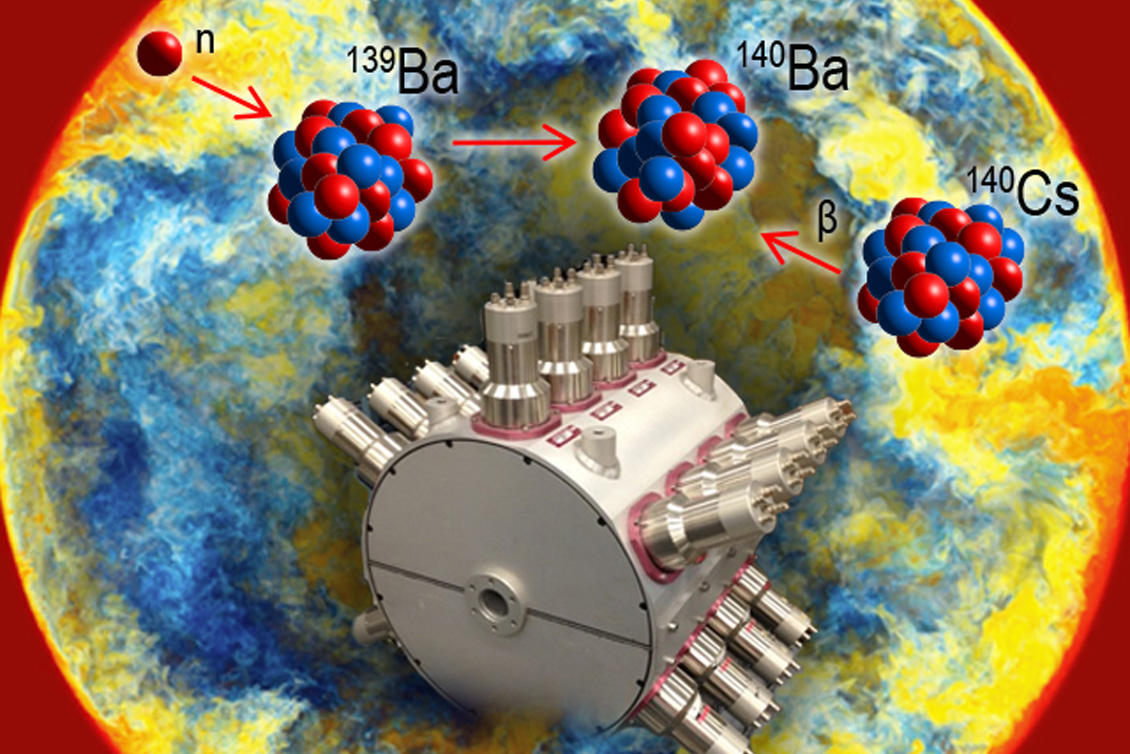Investigating the conditions for a new stellar process

Share this article:
Share this article:
A scientific research team studied how the barium-139 nucleus captures neutrons in the stellar environment in an experiment at Argonne National Laboratory’s (ANL) CARIBU facility using FRIB’s Summing Nal (SuN) detector. The team’s goal was to lessen uncertainties related to lanthanum production. Lanthanum is a rare earth element sensitive to intermediate neutron capture process (i process) conditions. Uncovering the conditions of the i process allows scientists to determine its required neutron density and reveal potential sites where it might occur. The team recently published its findings in Physical Review Letters (“First Study of the 139Ba(𝑛,𝛾)140Ba Reaction to Constrain the Conditions for the Astrophysical i Process”).
Artemis Spyrou, professor of physics at FRIB and in the Department of Physics and Astronomy at Michigan State University (MSU), and Dennis Mücher, professor of physics at the University of Cologne in Germany, led the experiment. MSU is home to FRIB, the only accelerator-based U.S. Department of Energy Office of Science (DOE-SC) user facility on a university campus. FRIB is operated by MSU to support the mission of the DOE-SC Office of Nuclear Physics as one of 28 DOE-SC user facilities.
Combining global collaboration and world-class educational experiences
The experiment was a collaborative effort involving more than 30 scientists and students from around the world. Participating institutions included the University of Victoria in Canada, the University of Oslo in Norway, and the University of Jyväskyla in Finland.
“The collaboration is essential because everyone comes from different backgrounds with different areas of expertise,” Spyrou said. “Together, we’re much stronger. It’s really an intellectual sharing of that knowledge and bringing new ideas to the experiment.”
The international collaboration also included five FRIB graduate and two FRIB undergraduate students. FRIB is an educational resource for the next generation of science and technical talent. Students enrolled in nuclear physics at MSU can work with scientific researchers from around the world to conduct groundbreaking research in accelerator science, cryogenic engineering, and astrophysics.
“Our students contribute to every aspect of the experiment, from transporting the instrumentation to unpacking and setting it up, then testing and calibrating it to make sure everything works,” Spyrou said. “Then, we all work together to identify what’s in the beam. Is it reasonable? Do we accept it? Once everything is set up and ready, we all take shifts.”
Measuring the i process
Producing some of the heaviest elements found on Earth, like platinum and gold, requires stellar environments rich in neutrons. Inside stars, neutrons combine with an atomic nucleus to create a heavier nucleus. These nuclear reactions, called neutron capture processes, are what create these heavy elements. Two neutron capture processes are known to occur in stars: the rapid neutron capture process (r process) and the slow neutron capture process (s process). Yet, neither process can explain some astronomic observations, such as unusual abundance patterns found on very old stars. A new stellar process—the i process—may help. The i process represents neutron densities that fall between those of the r and s processes.
“Through this reaction we are constraining, we discovered that compared to what theory predicted, the amount of lanthanum is actually less,” said Spyrou.
Spyrou said that combining lanthanum with other elements, like barium and europium, helps provide a signature of the i process.
“It’s a new process, and we don’t know the conditions where the i process is happening. It’s all theoretical, so unless we constrain the nuclear physics, we will never find out,” Spyrou said. “This was the first strong constraint from the nuclear physics point of view that validates that yes, the i process should be making these elements under these conditions.”
Neutron capture processes are difficult to measure directly, Spyrou said. Indirect techniques, like the beta-Oslo and shape methods, help constrain neutron capture reaction rates in exotic nuclei. These two methods formed the basis of the barium-139 nucleus experiment.
To measure the data, beams provided by ANL’s CARIBU facility produced a high-intensity beam and delivered it to the center of the SuN detector, a device that measures gamma rays emitted from decaying isotope beams. This tool was pivotal in producing strong data constraints during the study.
“I developed SuN with my group at the National Superconducting Cyclotron Laboratory, the predecessor to FRIB,” Spyrou said. “It’s a very efficient and large detector. Basically, every gamma ray that comes out, we can detect. This is an advantage compared to other detectors, which are smaller.”
The first i process constraint paves the way for more research
Studying the barium-139 neutron capture was only the first step in discovering the conditions of the i process. Mücher is starting a new program at the University of Cologne that aims to measure some significant i process reactions directly. Spyrou said that she and her FRIB team plan to continue studying the i process through different reactions that can help constrain the production of different elements or neutron densities. They recently conducted an experiment at ANL to study the neodymium-151 neutron capture. This neutron capture is the dominant reaction for europium production.
This material is based upon work supported by the National Science Foundation.
Michigan State University operates the Facility for Rare Isotope Beams (FRIB) as a user facility for the U.S. Department of Energy Office of Science (DOE-SC), supporting the mission of the DOE-SC Office of Nuclear Physics. Hosting what is designed to be the most powerful heavy-ion accelerator, FRIB enables scientists to make discoveries about the properties of rare isotopes in order to better understand the physics of nuclei, nuclear astrophysics, fundamental interactions, and applications for society, including in medicine, homeland security, and industry.
The U.S. Department of Energy Office of Science is the single largest supporter of basic research in the physical sciences in the United States and is working to address some of today’s most pressing challenges. For more information, visit energy.gov/science.

